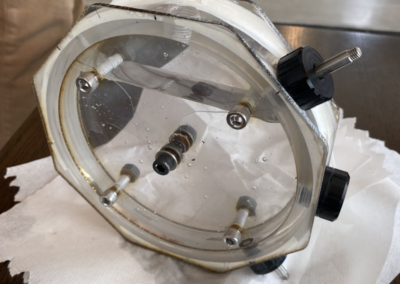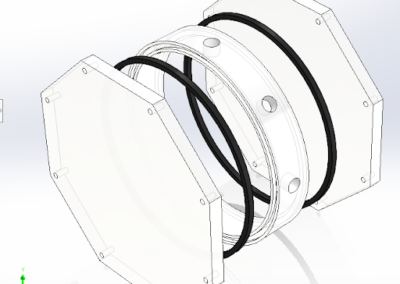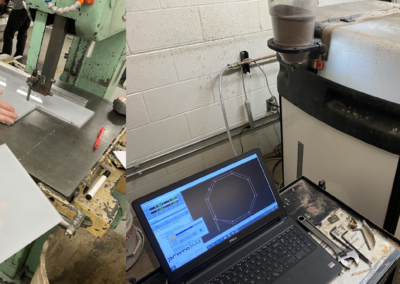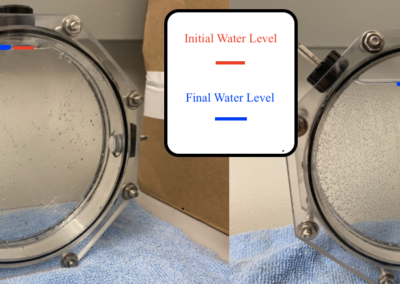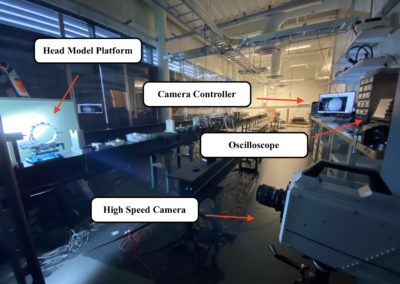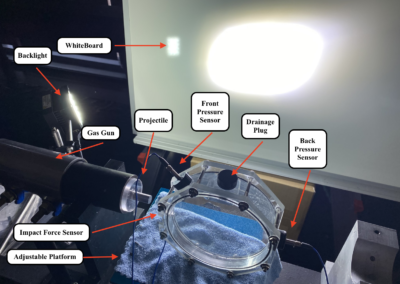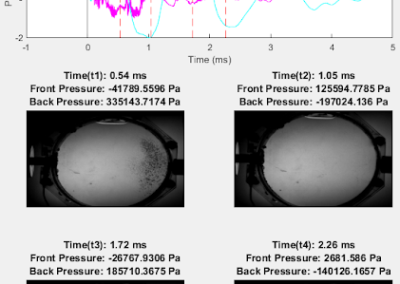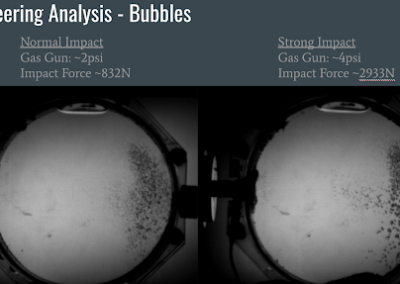Physical Head Model to Study Traumatic Brain Injuries
Overview
Each year, about 1.7 million people suffer a blow to the head that results in a traumatic brain injury (TBI). In the worst cases, TBIs can cause degradation in the individual’s cognitive processes, decline in quality of life, and death. Researchers at Mines’ X-STRM laboratory are studying cranial impacts to learn about modes of injury, which is useful in the development of helmets to prevent TBIs, as well as identifying cellular injury thresholds and drug development efforts. This project focuses primarily on the effects of cavitation on the human brain. Team Cerebral has been challenged with developing a physical head model that will measure the impact to the skull and provides viable biofidelic data which can then be translated into preventable measures against TBI in regard to cavitation.
In order to successfully study cavitation occurring in the brain, an optically clear model that is representative of the skull is necessary. Because an anatomically correct model does not have a closed form analytical solution, the client advised that the team rely on simplified geometries for analytical models, simulations, experiments for the purpose of this study. Team Cerebral and the client opted to move forward with a cylindrical head model design.
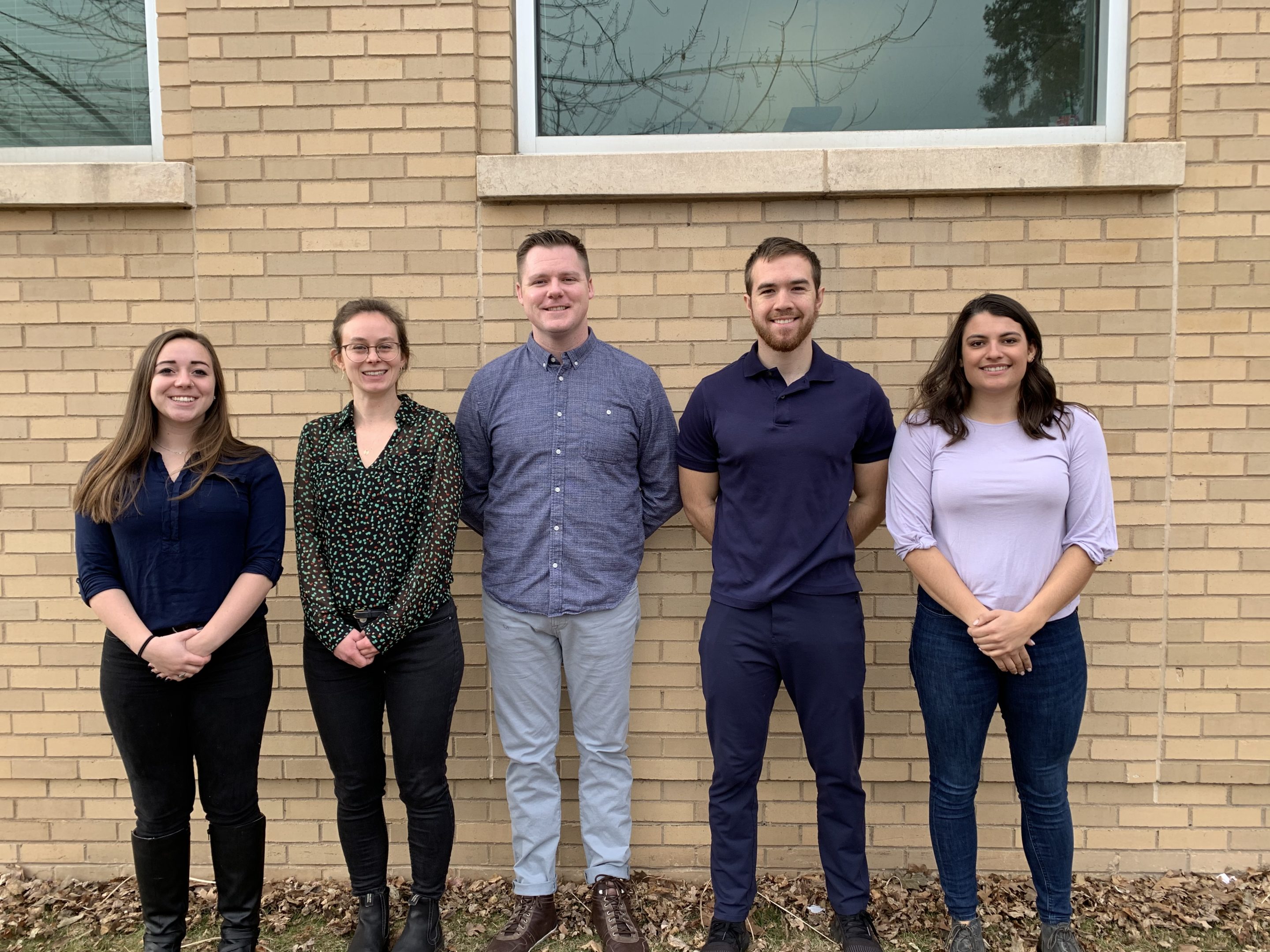
Live Zoom Chat
Use the link below to join us live from 8:00 – 10:30 a.m. on December 3.
Join from PC, Mac, Linux, iOS or Android: https://mines.zoom.us/j/3981952584?pwd=TkdJbDg5YzhkTFVWbGtXR0Qydk1YUT09
Password: cerebral20
Or iPhone one-tap: 12532158782,3981952584# or 13462487799,3981952584#
Or Telephone:
Dial: +1 253 215 8782 (US Toll) or +1 346 248 7799 (US Toll)
Meeting ID: 398 195 2584
International numbers available: https://mines.zoom.us/u/atg19JnTO
Or a H.323/SIP room system:
H.323: 162.255.37.11 (US West) or 162.255.36.11 (US East)
Meeting ID: 398 195 2584
Password: 3263266255
SIP: 3981952584@zoomcrc.com
Password: 3263266255
Team Members
- Rachel Godard
- Ernest Hernandez
- Nicole Lasater
- Jordan Lopez
- Patricia Robinson
The Client
- Dr. Stylianos Koumlis
- Dr. Leslie Lamberson
- X-STRM Lab @ Colorado School of Mines
Acknowledgements
Client: Dr. Stylianos Koumlis
Mines X-STRM Laboratory Chief: Dr. Leslie Lamberson
Project Advisor: Emily Sievers
Technical Advisors: Dr. Anne Silverman & Dr. Kristine Csavina
Consultants: Buddy Haun & Dr. Oyvind Nilsen
Video
Elevator Pitch
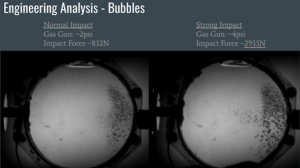
Design Approach
The physical head model is intended to retain the salient characteristics of the human head while being simple enough to allow for comparison against analytical solutions and computational modelling. The existing physical head model leaked and had hardware in the viewing frame used for data collection. The senior design team was tasked to update the current model to eliminate the fluid leakage and find alternative hardware positioning to eliminate viewing frame obstruction.
Our preliminary decisions included the shape of the head model (cylindrical or spherical), the material (acrylic or polycarbonate), and the manufacturing approach (3D printing, resin casting, or machining). We used this as a foundation for developing our design, but ultimately changed our design substantially!
As we narrowed in on our design, we modified our original approach according to feasibility. The design evolved to be a polycarbonate tube, capped on either end by two polycarbonate octagons machined from stock polycarbonate sheets, and bolted together. Our initial approach was to design a head model from scratch, but we ended up incorporating quite a bit of the original head model’s design. Ultimately, our design consisted of modifications to the original that solved the issues with it, primarily leakage and an obstructed viewing frame.
Sourcing the polycarbonate sheets was relatively easy. To cut octagonal end faces from the polycarbonate sheet, our initial plan was to use a mill. This was unsuccessful. We needed a more precise technique and ended up using a waterjet cutter, which worked well.
Procuring a polycarbonate tube was more difficult, and when we succeeded, we found that the tube was out of spec with regards to circularity. This presented a challenge to machining a groove for the o-ring. To address this, we procured a cylindrical steel rod and lathed it down to be slightly larger than the inner diameter of our tube. We then forced the tube onto the rod, using the rod as a mount for lathing the groove into the end faces of the tube.
Once we completed manufacturing the model we took it into the XSTRM Lab for testing. Here, there were design opportunities for improving how the client uses the model. We worked with the client to find a way to stabilize the model, improve the lighting, and specify the appropriate force to apply in testing. These testing sessions proved that the model operated as intended, and was indeed an improvement upon the original design.

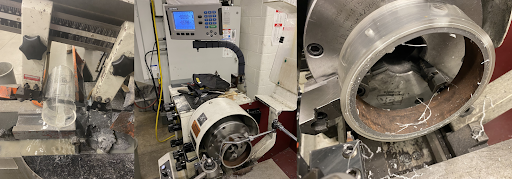
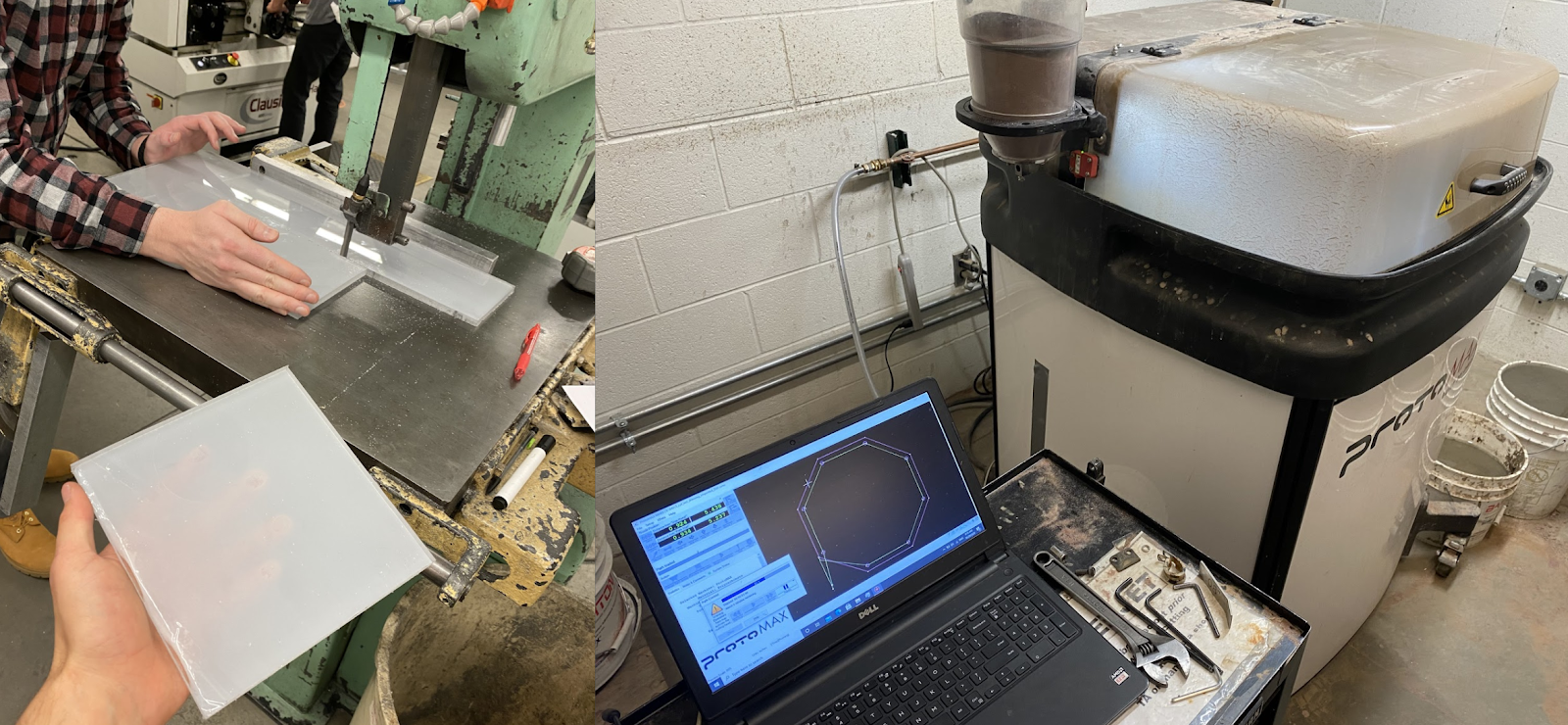
Design Solution
Our model is transparent to allow for capture of high-speed photography during cranial impact, watertight to contain the simulated cerebrospinal fluid (CSF), cylindrical to approximate the shape of a head, and mounted with sensors to collect data on pressure changes in the fluid. The sensor-mounting ports accommodate sensors used in the former model, and can be mounted with other sensors to collect different data as needed by the user.
PDR: Research and Decision Matrices
Our team’s preliminary goal was to understand the needs of the client. Helpfully, he provided us with literature on prior research that used head models akin to the model we were tasked with designing. From our research, we synthesized several design approaches for the different elements of the model. The discretized elements consisted of shape, sensor/fluid ports, material, manufacturing method, and sensors. Using a decision matrix, we weighed knowledge gained from our research, input from the client, and advice from faculty advisors to grade and rank the design approaches.
IDR: Design and Purchasing
In the second phase of the project, we refined our design and did most of the purchasing. Leading up to this point, our design consisted of decisions made for the disparate elements but wasn’t cohesive enough to be implementable. Further research and client communication done over the summer informed a new design path. We made sketches, talked to faculty advisors, and made revisions to create a realistic design. Ultimately, our design resembled the client’s original head model, but resolved two major issues: leakage and obstruction of the viewing frame.
With completed drawings of our design, we were given approval to start purchasing materials. After substantial time spent researching suppliers and corresponding with vendors, we were fortunate to source much of our material from local companies (which proved helpful in the build process, as we had to resupply to iterate).
|
Vendor |
Item Description |
Quantity |
Unit Cost |
Total Cost* |
|
Plasticare (Englewood) |
Polycarbonate sheets, ⅜” thick 2’ x 1’ |
3 |
$56.22 |
$168.66 |
|
Plasticare (Englewood) |
1 ft long polycarb tube, 6” OD, ¼” wall thickness |
1 |
$156.30 |
$156.30 |
|
K&K Steel (Brighton) |
steel tube – 5.65” OD, ¼’’ wall thickness, 3’ length |
1 |
$67.41 |
$67.41 |
|
The Home Depot |
Screws, #10-32 x 2-½” Hex SS socket cap screw (2-pack) |
4 |
$2.92 |
$11.68 |
|
The Home Depot |
Nuts, #10-32 SS Machine screw nut (4-pack) |
3 |
$1.18 |
$3.54 |
|
The Home Depot |
Washers, #10 SS flat washer (12-pack) |
2 |
$1.18 |
$2.36 |
|
McMaster-Carr |
O-Ring cord stock, neoprene 10’ , 1/16’’frac. width |
1 |
$5.00 |
$5.00 |
|
Amazon |
Gorilla super glue with brush & nozzle |
1 |
$6.48 |
$6.48 |
|
Grand total: |
$421.43 |
*Tax excluded
FDR: Build, Test, and Re-build
Our manufacturing approach evolved as we made our first attempts in the machine shop. Techniques we had planned to use were insufficiently precise or not feasible, and we had to re-strategize and be nimble as we moved through the build.
Once the build was complete, we worked with the client to test the model and improve the process of how the model would be used. Minor problems with our design were uncovered in testing, which were addressed by re-building the model.
Below, there are two videos of the old model (left) and the new model (right) during a test iteration. At first glance between the two videos, the field of view obstruction and leakage problem can be seen. As well as, the new model video shows the correct placement of the gas gun just left of the model before impact. Whereas, the old video shows the impactor sphere offset from the impact point which is one of the old experimental setup’s inconsistencies. Across all tests, we noticed that stronger impacts resulted in rapid pressure changes. At these exact moments, we saw that bubbles would form in the model. There was a positive correlation between impact force magnitude and the prevalence of bubbles. This observation reinforces the cavitation hypothesis we set out to explore. Pressure Graphic #1 shows a further breakdown of pressure vs. time during the new model’s test iteration.
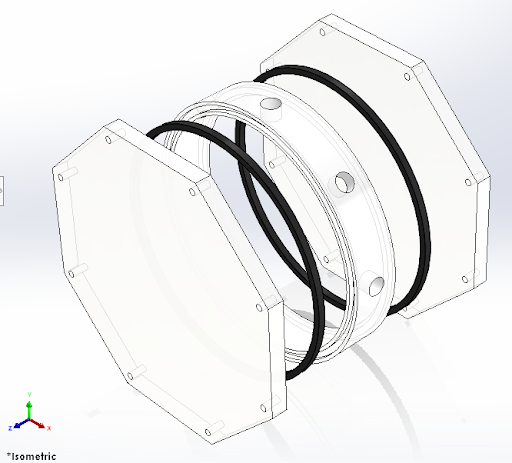
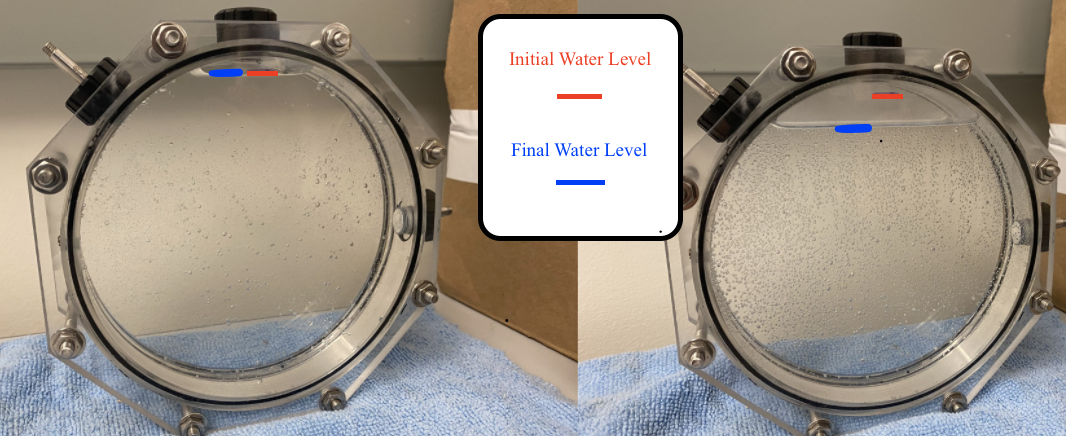

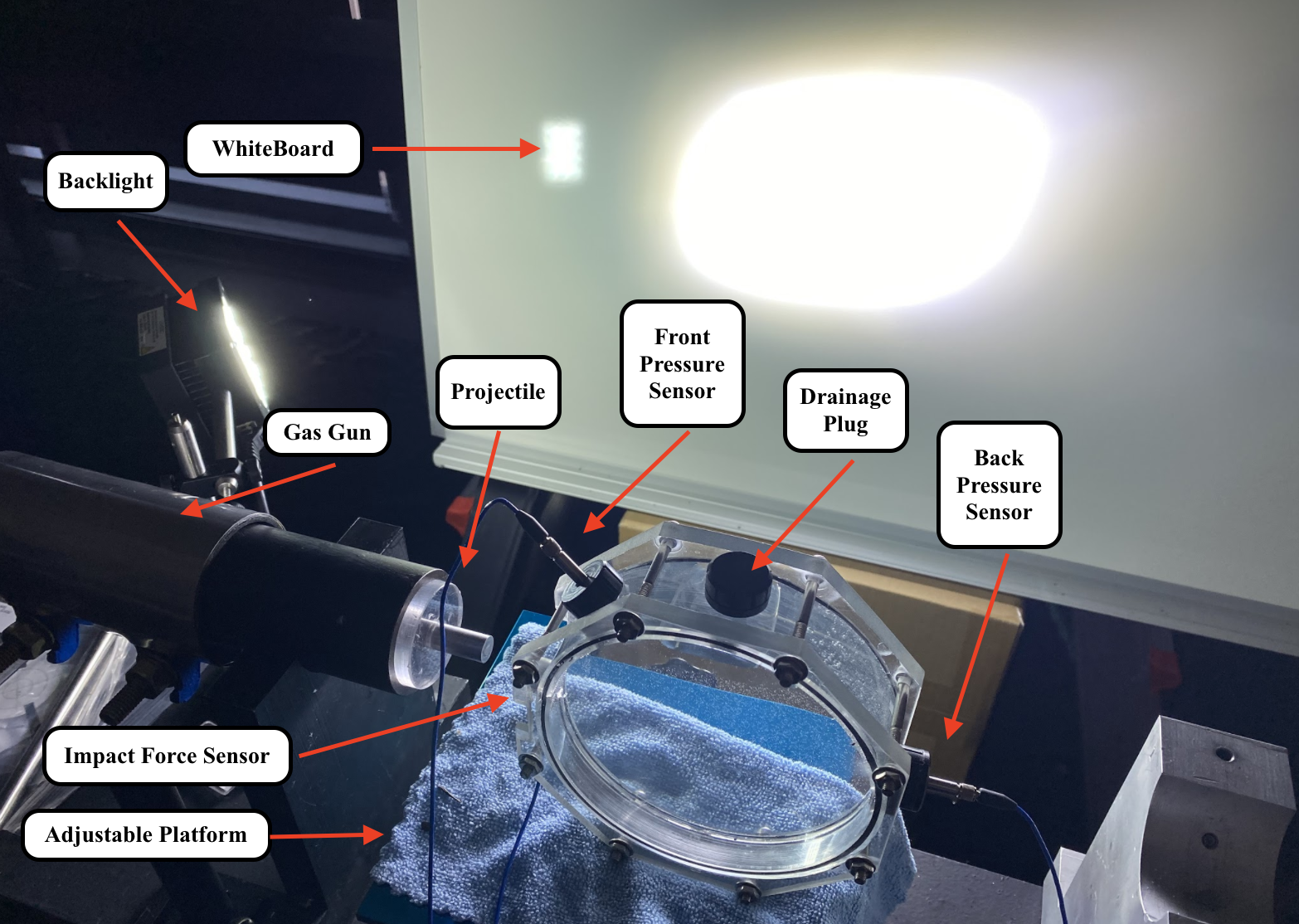
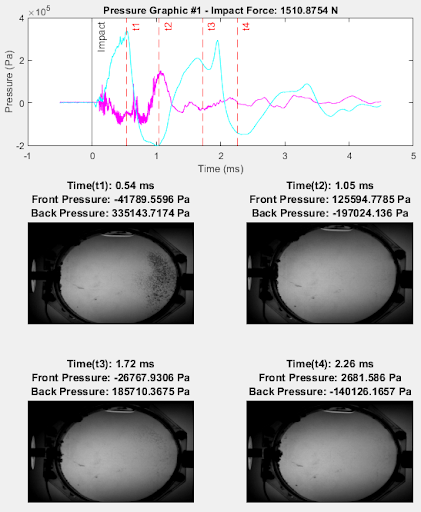
Next Steps
The final feedback from the client indicated that they were very satisfied with the model created by Team Cerebral and how the team had improved upon the previous design. The client was especially excited about the increased clarity in the field of view as well as the elimination of leakages from the articulating surfaces and port locations. However, while the final product was a vast improvement on the previous model, further steps could be taken to increase its efficacy and suitability for the client’s research:
- Incorporating a hydroacoustic sensor would provide more insight into the behavior of the simulated cerebrospinal fluid inside the model. This sensor could be fixed to one of the existing ports, or attached to a new port designed by another team.
- A neck fixture should be built to simulate the restrictions on head motion that are caused by a real neck, as the head is not a free-floating body.
The current design produces sufficient data for the client’s research, but ideally, these additions would be included in the final prototype produced by future teams.
Meet the Team
Rachel Godard
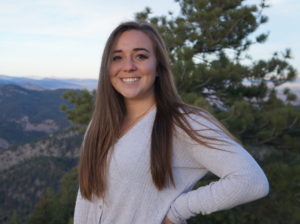
Rachel is graduating from Mines in December of 2020 with a B.S. in Mechanical Engineering. She is looking forward to continuing her education at Mines in the Spring to pursue her M.S. in Mechanical Engineering with a specialization in Biomechanical Engineering. Rachel aspires to work as a rehabilitation engineer or in the prosthetics and orthotics field in general. Outside of Mines, Rachel enjoys spending time with her friends, family, and dog, a cute basset hound named Earl, hiking, and snowboarding.
Ernest Hernandez
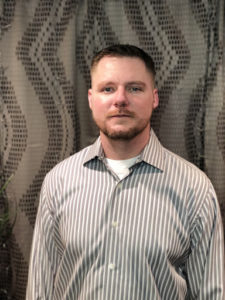 Ernest is a military veteran and undergraduate student completing his B.S. in Mechanical Engineering in December 2020. While he is eager to begin work in industry, he understands the significance of credentials and will begin a graduate degree in Spring 2021 studying Advanced Manufacturing at Mines. In the interim, he will pursue work as a mechanical engineer while primarily focusing on his graduate studies. His most notable accomplishments are honorably serving his country with service in Afghanistan where he earned numerous awards such as the coveted Combat Action Badge, and completing two Associate’s of Science degrees simultaneously while pursuing his Bachelor’s of Science in Mechanical Engineering. He strives to continuously improve himself and the things around him as he views nearly everything as a process that can be perfected.
Ernest is a military veteran and undergraduate student completing his B.S. in Mechanical Engineering in December 2020. While he is eager to begin work in industry, he understands the significance of credentials and will begin a graduate degree in Spring 2021 studying Advanced Manufacturing at Mines. In the interim, he will pursue work as a mechanical engineer while primarily focusing on his graduate studies. His most notable accomplishments are honorably serving his country with service in Afghanistan where he earned numerous awards such as the coveted Combat Action Badge, and completing two Associate’s of Science degrees simultaneously while pursuing his Bachelor’s of Science in Mechanical Engineering. He strives to continuously improve himself and the things around him as he views nearly everything as a process that can be perfected.
Nicole Lasater
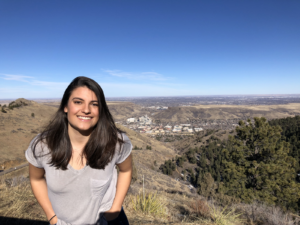 Nicole is a senior graduating in December 2020 with a BS in Mechanical Engineering and a minor in Biomechanical Engineering. She is passionate about doing work that benefits others and engineering solutions that positively impact society. Her goal is to work in the medical device industry researching and developing new technologies for prosthetics and implants. Outside of engineering, Nicole enjoys skiing, mountain biking, and spending time with friends and family.
Nicole is a senior graduating in December 2020 with a BS in Mechanical Engineering and a minor in Biomechanical Engineering. She is passionate about doing work that benefits others and engineering solutions that positively impact society. Her goal is to work in the medical device industry researching and developing new technologies for prosthetics and implants. Outside of engineering, Nicole enjoys skiing, mountain biking, and spending time with friends and family.
Jordan Lopez
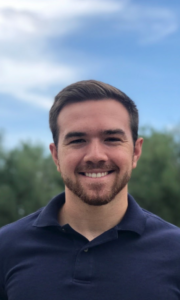 Jordan is a Senior at Colorado School of Mines studying Mechanical Engineering. At Mines, he became fascinated and inspired by what could be done within the biomedical sciences. In 2019, he was a Hardware Test Engineer Co-Op for Medtronic, doing work on their minimally-invasive brain surgery device. This experience, along with other motivators (including this Capstone Project to build a Physical Head Model for TBIs), has reinforced his goal to work in the medical devices field. Outside of school and work, he enjoys jamming out to Queen, rock climbing, and cooking up delicious meals with his family and friends.
Jordan is a Senior at Colorado School of Mines studying Mechanical Engineering. At Mines, he became fascinated and inspired by what could be done within the biomedical sciences. In 2019, he was a Hardware Test Engineer Co-Op for Medtronic, doing work on their minimally-invasive brain surgery device. This experience, along with other motivators (including this Capstone Project to build a Physical Head Model for TBIs), has reinforced his goal to work in the medical devices field. Outside of school and work, he enjoys jamming out to Queen, rock climbing, and cooking up delicious meals with his family and friends.
Patricia Robinson
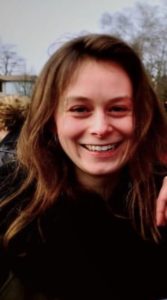 Patricia is graduating with a BS in Mechanical Engineering, supplementing her BS in Environmental Science. Between her first degree and beginning at Mines, she built a diverse resume, working as a naturalist and wilderness guide in SE Alaska and in marketing, strategy, and support for an architecture and interior design firm. Drawing on expertise from her background, she aims to incorporate biomimicry into her career, applying strategies found in nature to engineering design. In January she will begin working as a systems engineer in the aerospace industry, as part of a leadership development rotational program. When not working in front of a computer screen, Patricia likes to go birding and ride her bike to bakeries.
Patricia is graduating with a BS in Mechanical Engineering, supplementing her BS in Environmental Science. Between her first degree and beginning at Mines, she built a diverse resume, working as a naturalist and wilderness guide in SE Alaska and in marketing, strategy, and support for an architecture and interior design firm. Drawing on expertise from her background, she aims to incorporate biomimicry into her career, applying strategies found in nature to engineering design. In January she will begin working as a systems engineer in the aerospace industry, as part of a leadership development rotational program. When not working in front of a computer screen, Patricia likes to go birding and ride her bike to bakeries.
